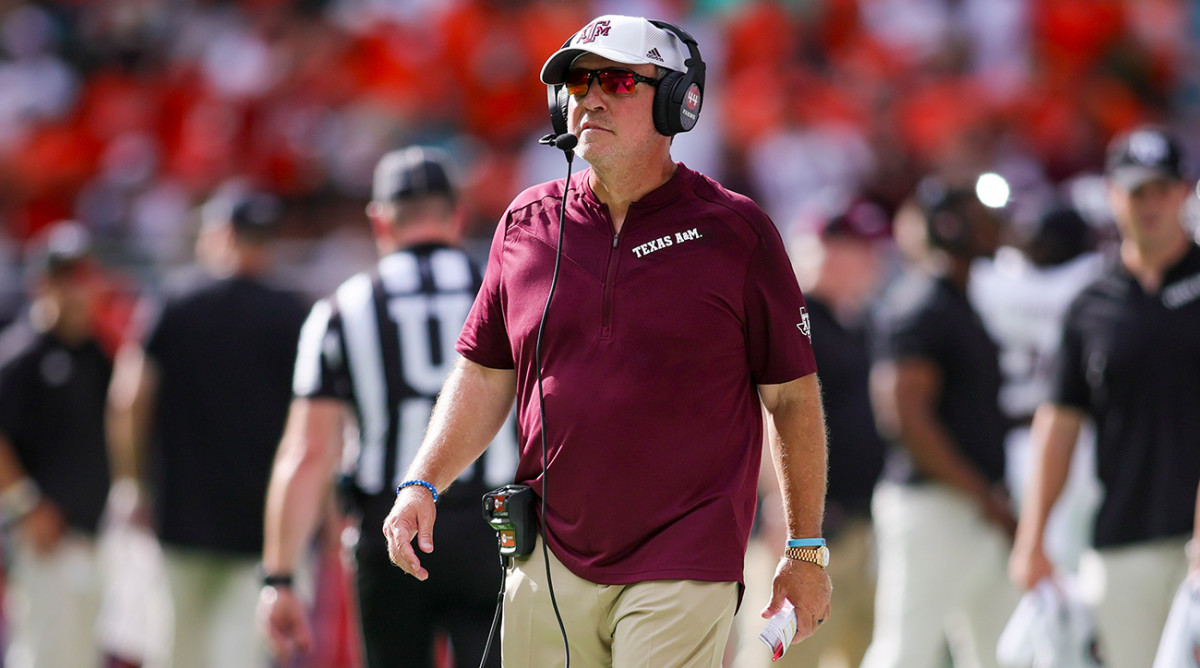Jimbo Fisher’s Gargantuan Texas A&M Contract No Longer Makes Sense

Nick Saban famously said Texas A&M “bought” a team with money from name, image and likeness, an allegation that looks sillier by the day. How could Texas A&M buy a team if it can’t even buy a coach?
Jimbo Fisher’s Aggies just lost to Miami, 48–33, to eliminate themselves from making their coach’s contract look defensible for the third straight year. But that’s O.K., because Fisher is due for another contract, with a nice raise, as soon as he does something to justify it, like sing the fight song, praise the 12th Man, win a public spat with a Hall of Fame coach or remind Texas A&M fans that nobody in the country loves them like he does.
Fisher is now 40–22 at A&M. He is 14–12 in the past three years. His team finished in the top 15 of the final AP poll once, in 2020. Yet A&M would owe him $76.8 million if it fired him, thanks to a contract and extension that appear to have been negotiated between two parties: Fisher and his agent.

Fisher can still change the landscape, though not in the way anybody in College Station envisioned. The era of paying a coach like he is a messiah should be over.
Four of the eight highest-paid coaches in college football have already lost a game. A fifth, Michigan State’s Mel Tucker, is 25–21 in his Spartans career and is now facing a sexual harassment charge. Those contracts are obviously not all the same. Alabama isn’t asking Nick Saban for its money back. But teams should stop paying so much for promise instead of performance.
Smart athletic directors should realize they don’t have to bend over backward and leave their wallets sticking out of their pockets whenever they negotiate with a coach. NIL dollars, conference consolidation and the transfer portal should shift leverage away from coaches and back toward the schools.
For years, ADs have thrown money at coaches for reasons that were not economically nor competitively sound. They did it because they thought it was their only way to sell hope. College teams couldn’t sign free agents. They couldn’t stack draft picks. But they could convince the fan base that one coach would transform their beloved program. Schools were not paying for results. They were paying for belief.
In that environment, overpaying was a marketing strategy. The more a school paid its coach, the better that coach must be. Overpaying him showed the school was “serious” about winning. This was in line with what many U.S. universities have done in the past few decades: raising the sticker price on tuition to create the perception of value.
Hope’s fraternal twin is fear, and that was the other force shaping the market. Fans feared a coach would leave and take that hope with him. This was especially true at schools like Texas A&M and Michigan State, which have rabid fan bases and a history of inconsistent performance.
But there are more ways to sell hope now. Teams with rabid fan bases should, logically, have the largest pools of NIL money to shower upon players. Put aside whether A&M did “buy” its recruiting class last year. What matters is A&M has the support to legally reward its on-field talent. It doesn’t just have to rely on a coach flashing a ring during recruiting or under-the-table payments.
Using NIL to improve talent levels is tricky—schools are not allowed to direct money to specific players, and if collectives pay based on recruiting rankings instead of college production, that can wreck team chemistry. But clearly, NIL is having a major effect on talent procurement and retention. Any coach can see that—and Texas A&M’s NIL power comes from the people who love Texas A&M. It doesn’t come from Jimbo Fisher.
It is common for the wealthiest boosters to subsidize the largest coaching contracts—or, if things go poorly, coaching buyouts. If you were an athletic director, would you ask a booster to pay tens of millions for one coach—or put that money into a collective that can improve the whole roster?
Realignment should also alter how schools view coaching contracts, for the simple reason that it reduces competition for the services of a top coach. The SEC and Big Ten are swallowing up the sport. Schools in those leagues should never fear a coach leaving for a school in any other conference. If, say, a Big Ten AD insists on a clause saying a coach cannot leave for another Big Ten school, then realistically, that coach would leave for only the SEC or the NFL. Even if the coach doesn’t agree to that clause, coaches interested in upward mobility have limited options. In a sport split into two economic tiers, the haves should not fear the have-nots.
The transfer portal should change the calculus even more dramatically. When Texas A&M signed Fisher away from Florida State, it gave him a 10-year, $75-million contract. After his single excellent season at A&M, in 2020, it reworked his contract, so he was signed for 10 years and $94.95 million.
Incredibly long-term contracts for college coaches were largely a recruiting pitch: If you come play for us, you will know your coach will be here for your whole career. But that shouldn’t mean much to players anymore. Players are constantly on the move, and they are well aware of their options. If their coach leaves, players can transfer and play right away. If their coach doesn’t play them, they can find a coach and school that will. Consciously or not, players are essentially making one- or two-year decisions when they pick a school. Why would they care whether a coach is signed for 10 years?
So much is changing so rapidly in college sports that it’s hard to keep track—and it is hard to see what all the ramifications will be. But Jimbo Fisher’s contract, like Jimbo Fisher’s success, feels like it belongs to the past.
